Pride FC Preview
We take a comprehensive look at Anchor's interpretation of the bloody Japanese fighting event.
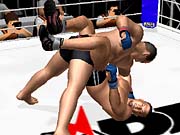
Anchor, the developer of the Ultimate Fighting Championship game for the Sega Dreamcast and WWF Raw for the Xbox, has been hard at work on its latest game--Pride FC for the PlayStation 2. Pride FC is based on the Pride Fighting Championship event, where the top fighters from the world of mixed martial arts engage in hand-to-hand combat to defend their own honor, as well as that of their chosen fighting style. Pride's roots lie in the Brazilian competitions of vale tudo, which stands for no holds barred, anything goes--Brazilian jujitsu versus kickboxing, shoot-fighting versus muay thai, judo versus Japanese pro wrestling, and to the winner goes the spoils and glory. The rules of Pride are fairly open, allowing for extensive options for both strikers and grapplers, although the specialized disciplines rarely dominate in today's Pride FC events, with the complete combatant--he who can fight while standing or while on the ground--often proving to be the victor. The fans in Japan look to Pride as an honored and near-legendary event, with their fighters pushed to celebrity status and respected as athletes and showmen of the highest caliber. While the Japanese event doesn't have mass-market popularity in the United States as of yet, due to limited pay-per-view access, mixed martial arts enthusiasts are quick to let you know that the best fighters in the world fight for Pride.
We've had a chance to play an early version of Pride FC extensively, and at first glance, the game bears a noticeable visual resemblance to Anchor's Ultimate Fighting Championship game. The fighters are modeled similarly, with a distinct focus on realism. Each character model is composed of more than 5000 polygons to accurately match up with the real-world athletes' physiques. Each fighter's health and stamina are represented by a single meter, which shows a full blue bar as health and diminishes into red with lost stamina. Stamina restores after inactivity, but unblocked strikes will deplete portions of the entire bar, thus reducing the fighter's overall reserves.
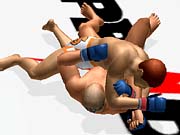
What differentiates Anchor's mixed martial arts games from traditional fighting games is the grappling aspect of the gameplay. Fighters can close in the distance and grapple with an opponent, which results in the fight being taken to the ground. When on the ground, one fighter has a dominant position over the other and can rain down powerful blows against the fighter on his back. There are three major positions when on the ground: the guard, the mount, and the back mount. The guard is the safest of the three positions for the defensive player--his legs are wrapped around the opponents' above the hips, so he is able to eliminate virtually all of his opponent's leverage. The mount is more dangerous, where the fighter on top is above the defending player's hips, meaning that he's free to rise up and put distance and power behind his strikes. The back mount usually results in a loss--it's where the fighter on bottom is turned around, often to avoid getting hit in the face, but then he is usually exposing his neck for a rear naked choke.
Submission victories are a crucial element of mixed martial arts and Pride FC--a successful submission maneuver will end a fight instantly, meaning that any fighter can win a fight at a moment's notice, no matter how beat up and battered. In a slight tweak of the submission system used in UFC, Pride FC gives defending players a longer opportunity to properly defend against a submission maneuver, making the movements seem more deliberate and realistic, as well as more balanced for beginning players.
The Combat System
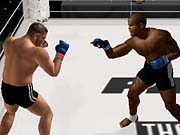
The essentials of the fighting system have also been translated over from Anchor's previous grappling game. Pride FC borrows a control scheme similar to that of Tekken, where four face buttons on the controller manipulate each of the fighter's limbs. Varying two-button combinations perform punch or kick counters, as well as shoots, where a fighter attempts to seize an opponent's legs and perform a takedown or bodyslam. In contrast to UFC matches, which take place in a steel octagon, Pride FC matches take place in a ring, and fighters are free to circle opponents to take full advantage of corners and ring ropes. The referee in Pride is more active than those in the UFC, resetting fighters in the center of the ring if they get too close to the ropes. While there is no in-ring referee in the Pride FC game, the rules will be in place and enforced.
Core to Anchor's fighting system is the use of quick taps on the control pad to perform back steps, front steps, and side steps, which can be performed in combination with strikes or shoot attempts to expand on each fighter's repertoire of available moves. For example, back step and right punch can perform a windup overhead punch for some fighters, while front step and the shoot combination can perform a leaping lunge tackle.
Pride FC expands on the fighting system found in the UFC games considerably--it introduces new transition positions, further simulating the many situations that occur during an actual no-holds-barred fight. When one fighter shoots in on an opponent, the opponent can now perform a sprawl maneuver, where he kicks his legs back and rests his upper body on the incoming fighter, avoiding a takedown. Fighters can sink in a guillotine choke from this position or aim a few glancing blows to the side of the aggressive fighter's head.
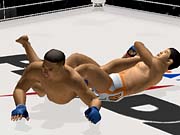
Fighters who initiate grapples from a standing position can also end up in a standing clinch or back clinch in Pride FC. Much like in a boxing clinch, the two fighters keep each other as close as possible to take away leverage and punching distance, although in mixed martial arts, this is an opportunity to sneak in strikes to the opponent or initiate a takedown or trip maneuver. The back clinch is a somewhat less-exposed version of the back mount in that a player gives an opponent his back in the hopes of taking advantage of a mistake or simply avoiding another painful strike.
Something that the UFC games lacked was the ability to knock down opponents without knocking them out--if a fighter hit the canvas as a result of a strike, he was always unconscious. Pride FC allows fighters to knock opponents down when hit with powerful strikes without making the defending fighter defenseless. After hitting the canvas, a fighter can remain seated and perform what is popularly known as the "butt-scoot," where he keeps his body facing the opponent and slides across the mat for positioning, without getting to his feet. A fighter performing the butt-scoot can taunt his opponent to come down into his guard using the punch buttons, or he can aim nasty kicks at an opponent's knees. A fighter on the ground can also trap an opponent's leg, taking him down to the mat to join him and in the transition obtaining superior positioning. Standing fighters against an opponent on the ground have their options severely limited. They can perform slapping kicks and punches to an opponent's legs, which the defending player can check to minimize damage. Just like in the actual events, a fighter who spends too much time on his back will have his stamina entirely depleted thanks to painful leg kicks.
Even positions that haven't changed considerably, such as the guard, have been tweaked to give certain fighters more options and never-before-seen moves. Some of the more aggressive "ground and pound" stylists can rise up while in an opponent's guard, putting a modicum of distance between them, so as to rain down harder punches.
Fighters Galore
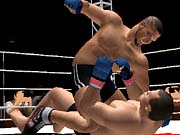
The list of fighters on the Pride FC roster in the version we played were Ricardo Arona, Tom Erikson, Don Frye, Kazuyuki Fujita, Allan Goes, Gary Goodridge, Renzo Gracie, Royce Gracie, Heath Herring, Dan Henderson, Enson Inoue, Daijiro Matsui, Guy Mezger, Carlos Newton, Antonio Rodrigo Nogueira, Alexander Otsuka, Kazushi Sakuraba, Semmy Schilt, Ken Shamrock, Akira Shoji, Vanderlei Silva, Nobuhiko Takada, Igor Vovchanchyn, and Gilbert Yvel.
This game marks several significant landmarks in terms of bringing these modern-day gladiators to video game form. While Carlos Newton, Guy Mezger, and Gary Goodridge have appeared in Ultimate Fighting Championship games, this is the first time that Western audiences who haven't imported pro wrestling games or watched the Pride pay-per-view DVDs will be able to see Antonio Inoki's popular Japanese pro wrestlers and Pride-exclusive fighters who make the events so spectacular. Crowd pleaser "Diet Butcher" Alexander Otsuka brings his unorthodox fighting style to the ring, alongside the simply spectacular Kazushi Sakuraba and Nobuhiko Takada, "the Hulk Hogan of Japanese pro wrestling," who represent the Takada dojo. Pride FC also marks the first official video game re-creation of mixed martial arts' first family and the innovators of Gracie jujitsu, the Gracies. Renzo and Royce represent the consummate grappling family with their respectable skills and considerable reputation.
Kazushi Sakuraba is a Japanese pro wrestler who has translated his considerable submission and grappling talents to stunning use in reality combat. When facing the top fighters in the world, he wows audiences with his use of cartwheels, flying stomps, two-handed Mongolian chops, and other displays of showmanship. Sakuraba's in-game character has many of these same moves, and the resemblance between the character model and the real-life fighter, both visually and in motion, is uncanny, including his open-handed stance and emotionless facial expression. Nobuhiko Takada, who tends to win his matches in stunning upsets, is able to recover stamina quickly while on his back in the butt-scoot, taking advantage of what, for any other fighter, would be a bad situation.
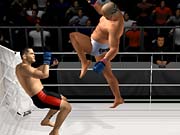
Alexander Otsuka brings with him a variety of unique moves, including two that he used in his fight against Mike "Rhino" Bourke at Pride FC: Battle of the Rising Sun. His comfort in the squared circle from his pro wrestling background gave him confidence to execute a standing dropkick, which was flashy but not altogether effective, although you can try to make better use of it in the game. But most stunning was the move he used to finish off the bigger man--a double armbar submission from the guard. Having been taken down by the bigger man, Otsuka was able to trap both of his arms, raise his legs around Bourke's neck, and then hyperextend both elbows, forcing the big man to tap out with his knee. We were able to make use of this move in the game, and it looked spot-on.
Heath Herring is a showboating, high-energy fighter from the States with a background in collegiate wrestling. In another display of Anchor's research into the Pride FC, Heath's moves set has an interesting re-creation of one of this young fighter's most memorable moments. During his Pride debut, in a match with Tom Erikson, a man formerly thought of as unbeatable, Heath was able to nullify the bigger man's offense with a tight guard, after which the fighters were made to stand back up on their feet. Heath then got pumped up--energetically, he clapped his hands together and bounced on his feet in anticipation. He then came out swinging with a powerful leg kick, stunning the big man and setting him up for a knockdown, followed by a rear naked choke. By pressing the square and circle buttons, you can make Heath's in-game character perform the same "pump up" routine and then follow up with the same weighty strike and submission combination.
Faithfully re-created are the moves and fighting styles of other Pride notables such as Vanderlei Silva, the Brazilian vale tudo fighter who was able to defeat Kazushi Sakuraba on two separate occasions, and Daijiro Matsui, the Japanese pro wrestler who has participated in numerous exciting Pride matches. Matsui, who has a knack for fighting out of submission holds, has a fairly innovative defense against an armbar. When seized by an opponent curled up around his arm in the hopes of securing a tapout, Matsui will lift the other fighter's entire body weight with his trapped arm and slam him down on his neck repeatedly, breaking the hold (and possibly a few vertebrae). In the game, Vanderlei was given a couple of trademark moves, which separate him from the pack as far as ferocity and brutality are concerned. He can rear back, take a couple of charging steps, and perform a jumping muay thai knee to the face, capable of knocking fighters to the mat outright. Against butt-scooting opponents, he employs a flying stomp to the face, which should make most reconsider the value of that position.
A Matter of Pride
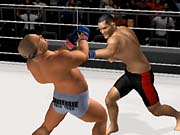
Part of what separates Pride FC from the UFC games is its slick presentation, which emulates the real-life events as closely as is currently possible. Fighters will have their genuine entrances, including their outfits and music. Heath Herring will come out in his full cowboy gear, while Royce Gracie will make his solemn entrance in the gi he fights in, alongside his entourage. These entrances are complicated affairs--with flashy pyrotechnics and lighting effects--and are comparable in production value even to those of American pro wrestling. The prefight rituals are also incredibly accurate in execution. The trademark Japanese announcer excitedly screams each fighter's name during his introduction, followed by the more reserved English-language announcer. Pride FC also introduces to fighting games a meaningful re-creation of the classic staredown. While the referee checks the fighters and informs them of the rules, both fighters glare intently at each other, sizing up the opposition. Once returned to their respective corners, the fighters raise their hands in anticipation, and the camera cuts to each of their intent faces. Each fighter looks ready for the bell to ring and to come out swinging. Postfight routines are also in the game, including "Big Daddy" Gary Goodridge's muscle pose-down and Carlos Newton's Dragon Ball Z-inspired kame-hame-ha fireball and backflip.
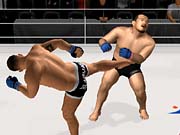
Many of the less-obvious aspects of Pride have also been accounted for in the Pride FC game. Between rounds, Pride's unmistakable ring-card girls will parade around the ring, while fighters sit in their corners being counseled by their cornermen and sipping water. The crowds that fill the jam-packed stadiums in Japan react to the action in the ring, conveying their excitement. And on a more basic level, Pride fights tend to be quite bloody, and while this feature wasn't in place in the version we played, blood will be represented in some form in the final version of the game. Pride FC will ship with a handful of different play modes to explore, including a versus game, a single-player arcade mode, and a Pride grand prix mode, which pits the fighters against one another in a seeded tournament format to see who comes out on top.
The Pride Fighting Championships may on the surface seem to be identical to the Ultimate Fighting events, but once the flashy presentation, fighters, and time-honored setting are taken into consideration, they are truly distinguishable from one another. Fans of the Pride Fighting Championships will immediately recognize that Anchor has studied footage of the real-life sporting events and has modeled each character's abilities and moves sets accordingly, based on the real-life performances and highlight reels. While these fighters are incredible to witness in person, Anchor has taken great pains to make their in-game characters perform just as impressively, which should make for memorable and exciting matches. In fact, Pride FC is shaping up to be the most realistic re-creation of real-life combat to ever appear in video game form. Check out our latest screens and movies of the game in action, and we'll have more on Pride FC for the PlayStation 2 as it approaches a stateside release.
Got a news tip or want to contact us directly? Email news@gamespot.com
Join the conversation